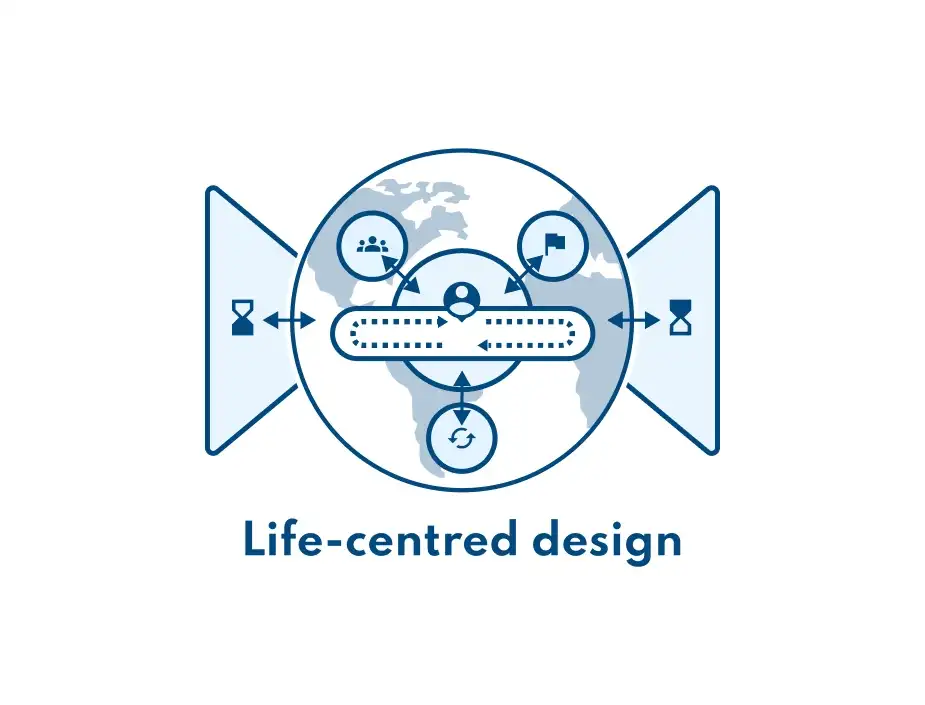Life-centred design is an emerging approach that expands on human-centred design by considering sustainable, environmental, and social implications.

Life-centred design is an emerging approach that expands on human-centred design by considering sustainable, environmental, and social implications.
What is the successor to Human Centered Design (Design Thinking)?
Is Life centered design the future and new way of working?
Damien Lutz, Founder of futurescouting.com.au and the author of Future Scouting and The Life-centred Design Guide inspired us with his article on medium. We summarized it for you and provide the link to his article for those who want to learn more about Life Centered Design.
Life-centred design is an emerging design approach that expands human-centred design to also include consideration of sustainable, environmental, and social implications. It connects micro-level design (UX, product engineering, etc.) to global goals by increasing the stakeholders from just ‘user and business’ to ‘user, non-user, local and global communities, ecosystems, and planetary boundaries’. This approach aims to create designs that not only benefit the user, but also consider the impact on the environment and society as a whole.
Some of the practices that support life-centred design have been in use for decades, such as circular design and systems thinking, but are only now becoming mainstream. Other practices, such as biomimicry, are still new and finding their place in the field. If you want to get better at transforming your mindset to one that creates value for others and the world around you, you might be interested in this this videocourse!
Despite its growing popularity, awareness of life-centred design is still relatively low, and it goes by many different names, such as planet-centred design, planet-centric design, conscious design, 21st-century design, environmental design, circular design, DesignX, respectful design, and humanity-driven design. All of these terms share the common goal of moving away from a focus on commercial and modernizing goals, in favour of more collaborative, inclusive, holistic, and sustainable approaches.
It is important to note that while life-centred design strategies are mostly relevant to the design of physical products and the design of a business, the life-centred lens opens our minds to the hybrid physical/digital nature of today’s creations and to the impacts of our digital-first experiences on the physical world. Therefore, life-centred design is for both physical and digital product designers, service designers, and business decision-makers.
A wider view of life-centred design connects product and experience designers working at the micro-level with global environmental and social goals at the macro-level, such as those of the Doughnut Economy and UN Sustainability Goals. The Doughnut Economy is an alternative economic model that promotes a “safe operating zone” between an outer ring of planetary boundaries that we should not overreach, and an inner ring of safe, just, meaningful, and thriving existence that all peoples must remain above. This approach aligns with the goals of life-centred design, as it focuses on creating designs that benefit not only the user, but also the environment and society as a whole.
In conclusion, life-centred design is an emerging approach that expands human-centred design to also consider sustainable, environmental, and social implications. It is important for designers and decision-makers to be aware of this approach and to consider its principles in their work in order to create designs that benefit not only the user, but also the environment and society as a whole.
Enjoy his wonderful and inspiring article: https://uxdesign.cc/life-centred-design-96965acdcbf4
Damien Lutz is a UX Designer and mentor, and the creator of the Future Scouting design game, guidebook, and tools. Follow Damien here on Medium.
Subscribe to our 3-weekly newsletter: The Innovators Journey to get valuable insights, tips, resources and special offers to drive change.
We are dedicated to helping individuals and organizations unlock their innovation potential. Our team offers a range of services including webinars, workshops, tailored programs, coaching, and training that can be tailored to fit your specific needs and goals. Whether you are a large group or an individual seeking one-on-one support, we have options to accommodate you. Contact us today to discover how we can help drive innovation and success within your organization.
Education
Public Service
Healthcare
Infra & Mobility
Tech & ICT
Food & Pleasure
Finance
STUDIO.WHY
Genteldijk 5
4191 LD Geldermalsen
The Netherlands
We set the language based on your browser settings. If you would like to visit the site in another language you are most welcome to select that here!